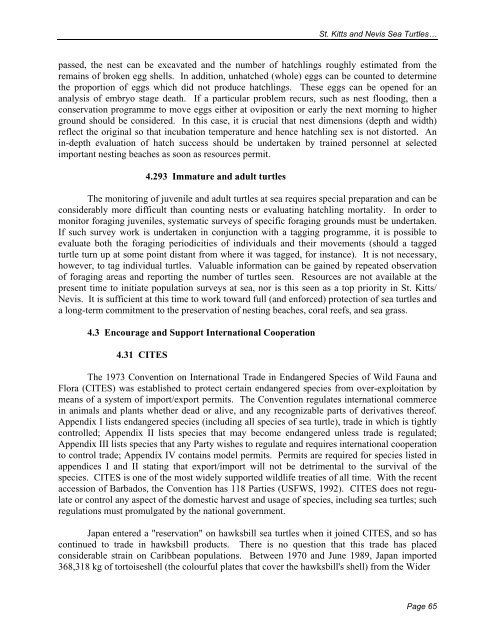Sea Turtle Recovery Action Plan for St. Kitts and Nevis - WIDECAST
Sea Turtle Recovery Action Plan for St. Kitts and Nevis - WIDECAST
Sea Turtle Recovery Action Plan for St. Kitts and Nevis - WIDECAST
Create successful ePaper yourself
Turn your PDF publications into a flip-book with our unique Google optimized e-Paper software.
<strong>St</strong>. <strong>Kitts</strong> <strong>and</strong> <strong>Nevis</strong> <strong>Sea</strong> <strong>Turtle</strong>s…<br />
passed, the nest can be excavated <strong>and</strong> the number of hatchlings roughly estimated from the<br />
remains of broken egg shells. In addition, unhatched (whole) eggs can be counted to determine<br />
the proportion of eggs which did not produce hatchlings. These eggs can be opened <strong>for</strong> an<br />
analysis of embryo stage death. If a particular problem recurs, such as nest flooding, then a<br />
conservation programme to move eggs either at oviposition or early the next morning to higher<br />
ground should be considered. In this case, it is crucial that nest dimensions (depth <strong>and</strong> width)<br />
reflect the original so that incubation temperature <strong>and</strong> hence hatchling sex is not distorted. An<br />
in-depth evaluation of hatch success should be undertaken by trained personnel at selected<br />
important nesting beaches as soon as resources permit.<br />
4.293 Immature <strong>and</strong> adult turtles<br />
The monitoring of juvenile <strong>and</strong> adult turtles at sea requires special preparation <strong>and</strong> can be<br />
considerably more difficult than counting nests or evaluating hatchling mortality. In order to<br />
monitor <strong>for</strong>aging juveniles, systematic surveys of specific <strong>for</strong>aging grounds must be undertaken.<br />
If such survey work is undertaken in conjunction with a tagging programme, it is possible to<br />
evaluate both the <strong>for</strong>aging periodicities of individuals <strong>and</strong> their movements (should a tagged<br />
turtle turn up at some point distant from where it was tagged, <strong>for</strong> instance). It is not necessary,<br />
however, to tag individual turtles. Valuable in<strong>for</strong>mation can be gained by repeated observation<br />
of <strong>for</strong>aging areas <strong>and</strong> reporting the number of turtles seen. Resources are not available at the<br />
present time to initiate population surveys at sea, nor is this seen as a top priority in <strong>St</strong>. <strong>Kitts</strong>/<br />
<strong>Nevis</strong>. It is sufficient at this time to work toward full (<strong>and</strong> en<strong>for</strong>ced) protection of sea turtles <strong>and</strong><br />
a long-term commitment to the preservation of nesting beaches, coral reefs, <strong>and</strong> sea grass.<br />
4.3 Encourage <strong>and</strong> Support International Cooperation<br />
4.31 CITES<br />
The 1973 Convention on International Trade in Endangered Species of Wild Fauna <strong>and</strong><br />
Flora (CITES) was established to protect certain endangered species from over-exploitation by<br />
means of a system of import/export permits. The Convention regulates international commerce<br />
in animals <strong>and</strong> plants whether dead or alive, <strong>and</strong> any recognizable parts of derivatives thereof.<br />
Appendix I lists endangered species (including all species of sea turtle), trade in which is tightly<br />
controlled; Appendix II lists species that may become endangered unless trade is regulated;<br />
Appendix III lists species that any Party wishes to regulate <strong>and</strong> requires international cooperation<br />
to control trade; Appendix IV contains model permits. Permits are required <strong>for</strong> species listed in<br />
appendices I <strong>and</strong> II stating that export/import will not be detrimental to the survival of the<br />
species. CITES is one of the most widely supported wildlife treaties of all time. With the recent<br />
accession of Barbados, the Convention has 118 Parties (USFWS, 1992). CITES does not regulate<br />
or control any aspect of the domestic harvest <strong>and</strong> usage of species, including sea turtles; such<br />
regulations must promulgated by the national government.<br />
Japan entered a "reservation" on hawksbill sea turtles when it joined CITES, <strong>and</strong> so has<br />
continued to trade in hawksbill products. There is no question that this trade has placed<br />
considerable strain on Caribbean populations. Between 1970 <strong>and</strong> June 1989, Japan imported<br />
368,318 kg of tortoiseshell (the colourful plates that cover the hawksbill's shell) from the Wider<br />
Page 65
















